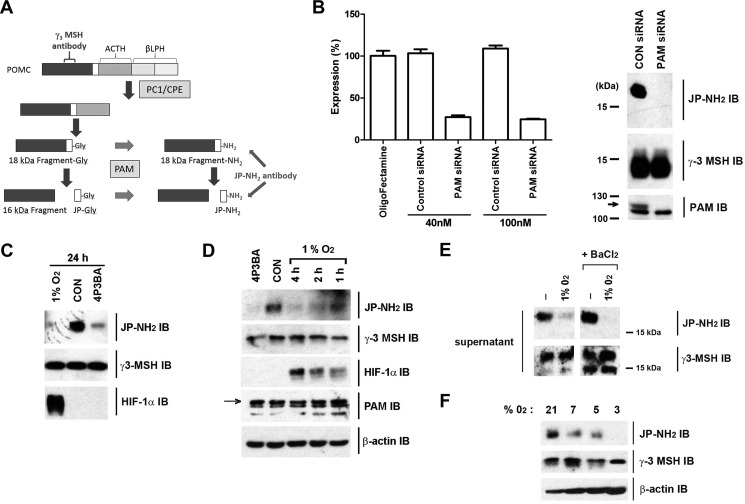FIGURE 7.
PAM-dependent amidation of POMC peptides is sensitive to oxygen in AtT20 cells. A, schematic representation of mJP processing from the N-terminal region of POMC illustrating the precursor fragments recognized by the γ3-MSH antibody (18-kDa Fragment-Gly, 18-kDa Fragment-NH2, and 16-kDa Fragment) and the JP-NH2 antibody (18-kDa Fragment-NH2 and JP-NH2). B, validation of PAM mRNA and protein knockdown following PAM siRNA treatment of AtT20 cells. RT-qPCR analysis (left panel) shows PAM mRNA levels normalized to HPRT and expressed as percentage expression relative to oligofectamine-treated cells (n = 3 technical replicates). Data are mean −/+ S.E. IB (right panel) of extracts prepared from control and PAM siRNA(40 nm)-treated AtT20 cells. The immunoactive band assigned as PAM by the siRNA analysis is marked with an arrow. The siRNA knockdown of PAM is accompanied by a loss of 18 kDa JP-NH2 immunoactivity with γ3-MSH immunoactivity unaffected. Note that the 16-kDa fragment (that is the predominant form detected by the γ3-MSH antibody in cell extracts) runs just below the 15-kDa marker on these gels. C and D, IB of AtT20 cell extracts either control (CON) or treated as indicated. 4P3BA was used at 250 μm. E, hypoxia inhibits amidation of constitutively secreted POMC 18-kDa fragment. IB of cell supernatants from normoxic or hypoxic AtT20 cells (1% O2 for 8 h) or parallel cells stimulated to secrete by incubation with BaCl2 (2 mm). The 18-kDa fragment-NH2 polypeptide is selectively removed from the regulated secretory pathway during secretory granule maturation and undergoes a constitutive-like secretion. In contrast, the 16-kDa fragment is retained with mJP in the mature granules and undergoes regulated secretion in response to secretagogues. These differential responses of the 18-kDa fragment and 16-kDa fragment were confirmed by IB using the γ3-MSH antibody while the JP-NH2 IB indicated the effect of hypoxia to reduce amidation status of the constitutively secreted 18-kDa Fragment-NH2. F, AtT20 cells were incubated for 4 h at the indicated oxygen concentrations.

